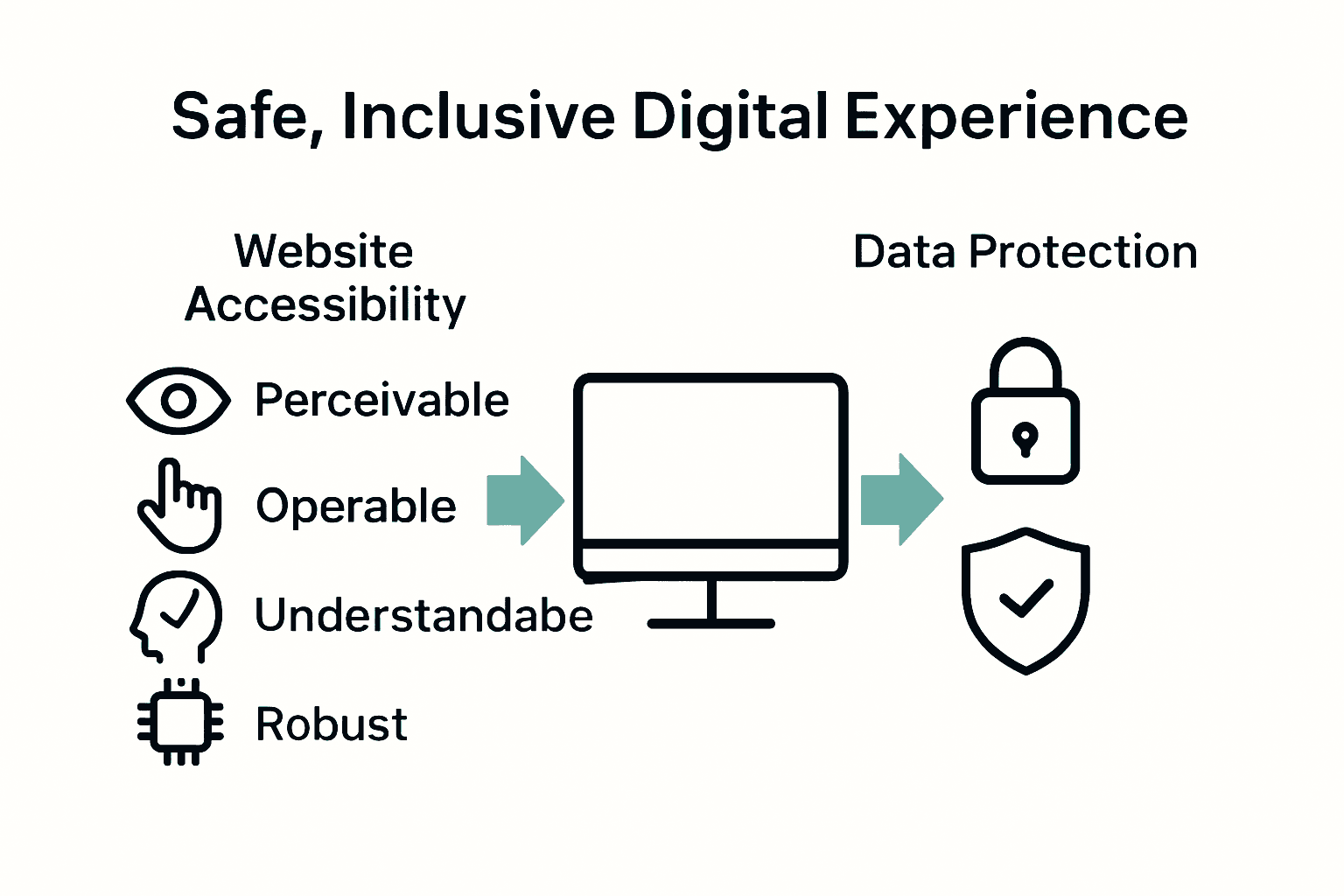Website Compliance Checklist: Complete Guide for 2025
More than 90 percent of websites have at least one compliance issue affecting accessibility, privacy, or security. Staying current with digital regulations is not just about avoiding fines, it is about providing a safe and inclusive online experience for every visitor. By understanding the essential concepts and practical steps behind website compliance, businesses can protect themselves from costly mistakes while building trust and credibility with their users.
Table of Contents
- Website Compliance Checklist: Core Concepts
- Key Website Compliance Types and Laws
- Essential Accessibility and Data Protection Standards
- GDPR, Cookies, and Privacy Requirements
- Common Compliance Risks and Mistakes to Avoid
Key Takeaways
| Point | Details |
|---|---|
| Website Compliance Fundamentals | Compliance frameworks ensure websites meet legal and accessibility standards, mitigating risks and enhancing user inclusivity. |
| Importance of Digital Accessibility | Accessibility features like alternative text and keyboard navigation are essential for accommodating diverse user abilities. |
| Proactive Compliance Approach | Continuous education and regular audits are crucial for adapting to evolving regulations and maintaining compliance integrity. |
| Risks of Non-Compliance | Common pitfalls include lack of alternative text and poor navigation, which can damage credibility and lead to financial penalties. |
Website Compliance Checklist: Core Concepts
Website compliance represents a strategic framework ensuring digital platforms meet legal, accessibility, and functional standards. Understanding these core concepts protects businesses from potential legal risks while creating inclusive online experiences. According to Washington University, digital compliance revolves around four fundamental principles: perceivable, operable, understandable, and robust content.
Digital Accessibility forms the cornerstone of website compliance. This means designing web experiences that accommodate users with diverse abilities and technological constraints. Key elements include:
- Providing alternative text for images
- Ensuring keyboard navigation functionality
- Creating colour contrast that supports visual comprehension
- Developing consistent page structures
- Supporting screen reader compatibility
Comprehensive website compliance extends beyond accessibility. HHS recommends websites also address critical domains like mobile responsiveness, clear navigation pathways, robust privacy policies, and secure hosting infrastructures. Small businesses must proactively implement these standards to mitigate potential legal challenges and demonstrate professional digital maturity.
Implementing a robust compliance strategy requires systematic evaluation and continuous improvement. Regular audits, user testing, and staying informed about evolving digital standards will help organisations maintain cutting-edge, inclusive web experiences that serve diverse user needs while meeting regulatory expectations.

Key Website Compliance Types and Laws
Website compliance encompasses a complex landscape of legal requirements designed to protect users, ensure accessibility, and maintain digital integrity. Different types of compliance standards address specific aspects of online interactions, ranging from accessibility and privacy to data protection and industry-specific regulations.
Accessibility laws form a critical component of website compliance. WebAIM highlights Section 508, a pivotal standard requiring digital platforms to be accessible to individuals with disabilities. These standards mandate comprehensive requirements such as:
- Providing text alternatives for non-text content
- Ensuring keyboard navigability
- Creating sufficient colour contrast
- Supporting assistive technology compatibility
- Delivering clear and predictable web interactions
Legal Frameworks extend beyond accessibility. Different industries and regions have unique compliance mandates. For instance, healthcare websites must adhere to HIPAA regulations, while European websites require GDPR compliance. Higher Education Compliance Alliance notes that organisational websites must systematically track and implement relevant legal requirements, which can vary significantly based on sector, geographical location, and target audience.
Navigating website compliance requires a proactive, multifaceted approach. Businesses must continuously educate themselves about evolving digital regulations, conduct regular audits, and implement robust systems that not only meet current standards but anticipate future legislative developments. Investing in comprehensive compliance strategies protects organisations from potential legal challenges while demonstrating a commitment to inclusive, user-centric digital experiences.
Essential Accessibility and Data Protection Standards
Accessibility and data protection standards form the backbone of responsible digital experiences, ensuring websites are both inclusive and secure. These interconnected frameworks protect user rights, enhance digital interactions, and establish critical guidelines for online platforms across diverse industries and user needs.
WebAIM provides comprehensive guidance through the Web Content Accessibility Guidelines (WCAG), which establish four fundamental principles of digital accessibility:
- Perceivable: Information must be presentable to users in ways they can perceive
- Operable: User interfaces and navigation must be manageable by all users
- Understandable: Content and operation must be clear and predictable
- Robust: Content must be compatible with current and future assistive technologies
Data protection standards complement accessibility requirements by safeguarding user information and privacy. Tennessee County Technical Assistance Service emphasises the importance of implementing robust security protocols that go beyond basic compliance. These protocols include encryption, secure data storage, transparent privacy policies, and user consent mechanisms.
Successful implementation of accessibility and data protection standards requires a holistic approach. Organisations must view these standards not as bureaucratic checkboxes, but as fundamental commitments to user experience, digital inclusivity, and ethical technology practices. Regular audits, ongoing staff training, and proactive adaptation to evolving regulatory landscapes are essential for maintaining comprehensive digital standards that truly serve all users.

GDPR, Cookies, and Privacy Requirements
Privacy regulations have transformed digital interactions, creating a complex landscape of user data protection and consent management. Websites must now navigate intricate legal frameworks that prioritise individual privacy rights and transparent data handling practices.
Cookie Compliance represents a critical component of modern privacy requirements. Websites must implement clear, granular consent mechanisms that allow users to:
- Understand what data is being collected
- Choose which types of cookies they permit
- Easily withdraw consent
- Access their personal information
- Request data deletion
HHS emphasises the importance of comprehensive privacy policies that go beyond basic legal compliance. These policies should provide transparent explanations of data collection processes, user rights, and the specific purposes for which personal information will be used.
Effective privacy management requires a proactive, user-centric approach. Organisations must view privacy not as a legal obligation, but as a fundamental aspect of building trust with their digital audience. This means continuously updating privacy practices, conducting regular privacy impact assessments, and maintaining clear, accessible communication about how user data is collected, processed, and protected.
Common Compliance Risks and Mistakes to Avoid
Website compliance is a minefield of potential pitfalls that can expose organisations to legal risks, financial penalties, and reputational damage. Understanding these common mistakes is crucial for proactively protecting digital assets and maintaining user trust.
Connecticut State Government highlights critical accessibility risks that organisations frequently overlook:
- Missing Alternative Text: Failing to provide descriptive text for images
- Insufficient Color Contrast: Creating unreadable design elements
- Keyboard Navigation Barriers: Preventing users from accessing content without a mouse
- Complex Navigation Structures: Making websites difficult to understand
- Inconsistent Content Formatting: Reducing readability and comprehension
University of Illinois Library emphasises that content quality directly impacts compliance. Redundant, outdated, or inaccurate information can undermine an organisation’s credibility and potentially violate regulatory standards. Websites must implement robust content management processes that ensure information remains:
- Unique and original
- Consistently updated
- Accurate and verifiable
- Aligned with current regulatory requirements
- Accessible across different user devices and assistive technologies
Mitigating compliance risks requires a holistic, proactive approach. Organisations should view compliance not as a one-time checklist, but as an ongoing commitment to digital excellence. Regular audits, continuous staff training, and staying informed about evolving regulatory landscapes are essential strategies for maintaining comprehensive website standards that protect both users and the organisation.
Simplify Your Website Compliance with Intelligent Automation
Ensuring your website meets all compliance requirements can feel overwhelming. From digital accessibility essentials like providing alternative text and ensuring keyboard navigation to navigating complex regulations such as GDPR and cookie consent, the stakes are high. Missing these details risks legal challenges and damages user trust. The Website Compliance Checklist highlights common pitfalls like insufficient colour contrast and unclear privacy policies that small businesses often struggle to fix.
That is where automation and smart systems become invaluable. At Fame Razak, we specialise in helping small businesses and agencies transform these tricky, time-consuming compliance tasks into streamlined, scalable processes. With solutions for workflow orchestration, AI-powered receptionists, and beyond, you can ensure your website stays accessible, secure, and updated without draining your resources.
Ready to stop worrying about compliance risks and focus on growing your business? Explore how automating your digital operations can bring peace of mind today. Visit Fame Razak to discover practical tools that turn complex challenges into simple solutions.
Frequently Asked Questions
What is website compliance?
Website compliance refers to a strategic framework ensuring digital platforms meet legal, accessibility, and functional standards to protect businesses and create inclusive online experiences.
Why is digital accessibility important for website compliance?
Digital accessibility ensures that web experiences accommodate users with diverse abilities and technological constraints, thereby fulfilling legal obligations and promoting inclusivity.
What are the key principles of the Web Content Accessibility Guidelines (WCAG)?
The key principles of WCAG include Perceivable (content must be presentable in ways users can perceive), Operable (user interfaces must be manageable by all), Understandable (content must be clear), and Robust (content must be compatible with assistive technologies).
What are common compliance risks that organizations face?
Common compliance risks include missing alternative text for images, insufficient color contrast, keyboard navigation barriers, complex navigation structures, and maintaining outdated or inaccurate content.
